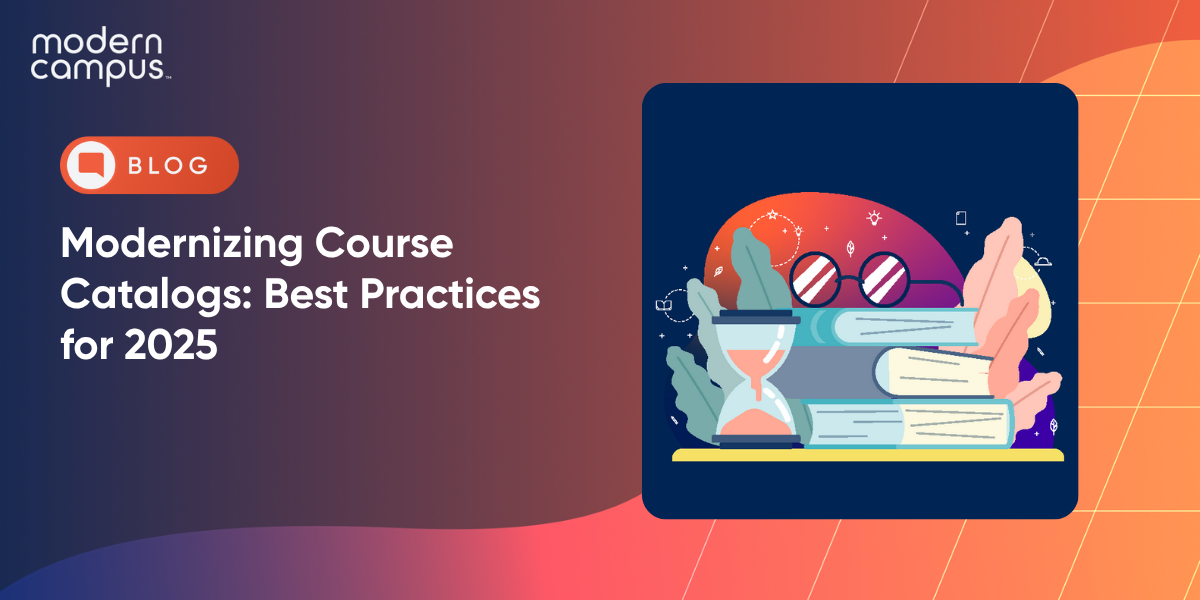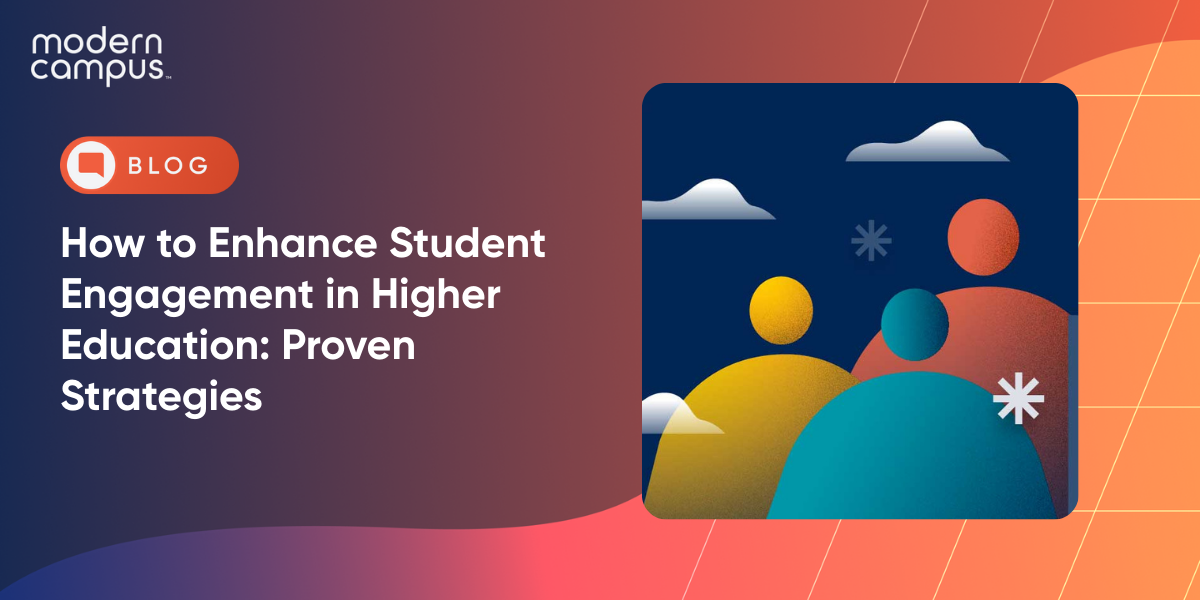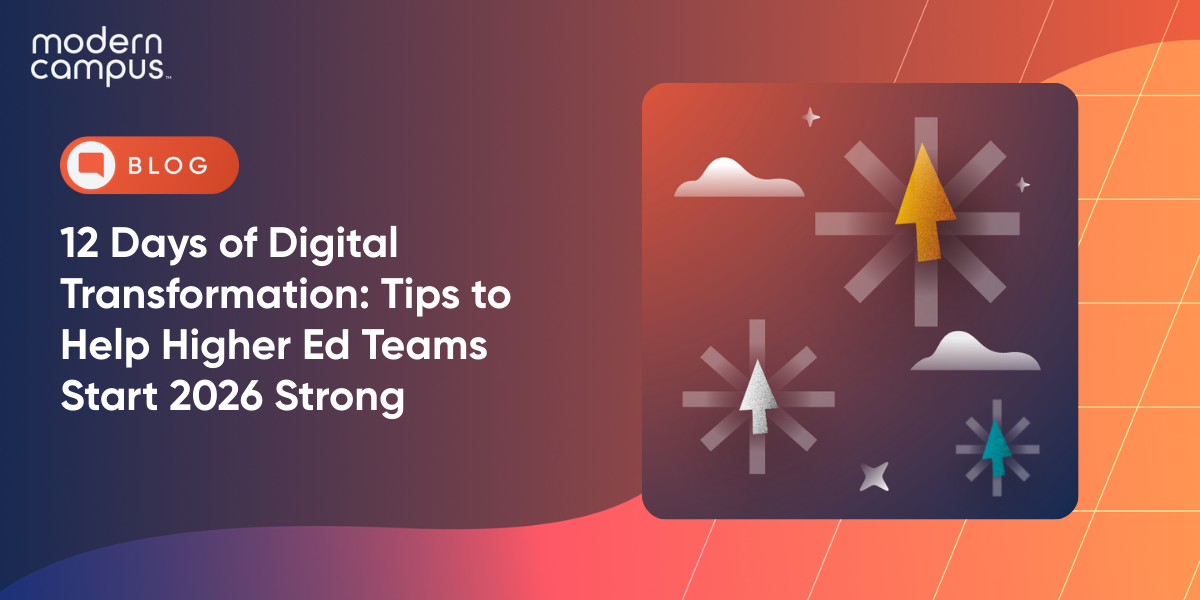Modernizing Course Catalogs: Best Practices for 2025
As 89% of businesses invest in personalized digital experiences, the traditional course catalog is no longer enough to meet student expectations. Outdated PDFs and static webpages fail to deliver the real-time accuracy, usability and mobile accessibility that students demand. Digital native learners expect a seamless, intuitive experience when researching programs, building schedules and planning their academic paths. The need for dynamic, user-friendly online course catalog software is imperative.
As institutions strive to increase enrollment, streamline operations and retain more students, the course catalog is a pivotal tool in shaping the student experience. To truly support students across the entire learner-to-earner journey, catalogs must act as personalized, interactive guides that connect students with academic requirements, career outcomes and campus resources. In this blog, we’ll explore the most effective ways to modernize your catalog for 2025, including best practices for UX/UI design, backend integration and ongoing content optimization.
Why Your Online Course Catalog Software Needs an Upgrade in 2025
As student expectations and institutional priorities evolve, the course catalog is no longer just a repository of academic policies and degree requirements. It’s now a central part of the digital experience that influences everything from a student’s first impression to their decision to enroll, persist and complete a credential. Updating your online course catalog software to reflect these modern needs is essential for student satisfaction and institutional competitiveness.
Learner Expectations Are Shifting: Is Your Catalog Keeping Up?
Modern learners approach academic planning the same way they shop, stream content or explore job listings: online, on mobile devices and with a strong desire for personalization. They want clear, fast access to course details, pre-requisites and how a program connects to career outcomes. Static catalogs and clunky navigation frustrate this process, pushing prospective students away before they ever apply.
An academic catalog must feel like a well-designed digital product. Whether they’re browsing on a smartphone during their commute or comparing programs late at night, students expect streamlined navigation, mobile responsiveness and intuitive tools. Institutions that fall short risk losing both trust and enrollment.
The Role of Online Course Catalogs in Student Success and Retention
A dynamic catalog informs and empowers. When integrated with curriculum management software, catalogs can automatically update program information, reflect real-time course availability and provide pathways to completion. This level of clarity helps reduce registration errors, missed requirements and advising bottlenecks.
More importantly, catalogs with built-in personalization and search functionality help students connect the dots between academic choices and career goals. When paired with labor market data or persona-based browsing, catalogs become a decision-making engine. By combining thoughtful UX with powerful academic catalog software, institutions can support retention from day one through graduation.
Best Practices for Online Course Catalog Software in 2025
To meet evolving student expectations and operational needs, institutions must treat their catalog like a strategic digital asset. The following best practices will help ensure your online course catalog software is a competitive differentiator in 2025.
Ensure Mobile-First and ADA-Compliant Design
When college students spend eight to ten hours per day on their smartphones, your catalog must be mobile-first, not just mobile-friendly. Responsive layouts, collapsible sections and thumb-friendly navigation are expected. Equally important is accessibility. ADA-compliant design ensures all students, including those with disabilities, can engage fully with your catalog content.

Institutions should prioritize clean design, high-contrast visuals, intuitive icons and accessible content structure (headers, alt text, keyboard navigation). Compliance meets legal requirements, but it also reflects your institution’s commitment to equity and student success.
Integrate Curriculum Management Software for Real-Time Updates
One of the most significant pain points for institutions is keeping catalog content accurate and up to date. By integrating your catalog with a modern curriculum management software solution, updates made by curriculum committees or departments can be reflected instantly in the student-facing catalog.
This connection eliminates redundant data entry, reduces the risk of misinformation and ensures that students always see the most current course offerings and requirements. It also empowers staff to focus on strategic work, like analyzing enrollment trends or refining program offerings, rather than chasing down edits in PDFs.
Support Career Pathways with Linked Outcomes and Job Data
Students want a direct line between what they study and where it can take them. However, studies found that 28% of college-level credentials don't align with any specific job market opportunities. It's up to institutions to correct this misalignment and help students find value in their educational decisions.
Embedding career outcomes, job market data and alumni success stories directly into your catalog listings enhances relevance and engagement. When a program page includes links to potential careers, average salaries and skill requirements, it becomes a tool for informed decision-making.
Institutions can go a step further by integrating their academic catalog software with external labor databases or internal career services content. You can boost the catalog’s value while aligning it with broader institutional goals around retention, career readiness and lifelong learning.

Enhancing UX/UI to Build a Better Catalog Experience
Modern students judge digital experiences quickly, often within seconds. A poorly designed course catalog can create friction that deters engagement, confuses users or erodes trust. By focusing on user experience (UX) and user interface (UI) design, institutions can transform their online course catalog software into a digital asset that supports student recruitment, enrollment and retention.
Prioritize Clear Navigation and Intuitive Layouts
Students don’t want to “figure out” your catalog; they expect it to guide them. A modern catalog should offer a clean, visual structure with intuitive categories like “Undergraduate,” “Graduate” and “Professional Programs,” along with prominent search and filter functionality.
Use progressive disclosure to avoid overwhelming users. For instance, group content into digestible sections and let users click to reveal details like prerequisites or course outcomes. Sticky headers, breadcrumbs and collapsible menus also help users stay oriented as they explore. Avoid academic jargon where possible. Instead, use plain language and microcopy that clearly communicates what each link or section offers.
Navigation design should also support different entry points. Some users will arrive from the homepage, others from a program page or an external search. Use anchor links, contextual callouts (e.g., “Interested in Data Science? View related certificates”) and persistent navigation elements to support exploration from any direction.
Use Personalization to Guide Decision-Making
Generic catalogs are becoming obsolete. Students expect content tailored to their goals, interests and stage in the enrollment journey. Incorporating smart UX features, like location-aware content, persona filters (e.g., "First-Time Student" or "Career Changer") and recently viewed items, can help users quickly find what matters most.
Dynamic content blocks that change based on user behavior or declared interests can increase engagement and reduce dropout. For example, if a user explores multiple health sciences courses, the system could surface related degree programs, licensure requirements or local job openings. These personalized pathways elevate your academic catalog software from a static archive to an interactive advising tool.
Optimize for Search Internally and Across Engines
Students won’t explore what they can’t find. Your catalog’s internal search functionality should allow keyword, course number and topic-based queries, delivering fast, relevant results with preview snippets and filtering options. Include synonyms and related terms in metadata so that “CompSci” and “Computer Science” return the same results.
External search optimization is just as important. Your online course catalog software should be SEO-friendly, with structured data markup, indexable URLs and clear metadata that makes catalog pages easy to find via Google. Course pages should also include rich content, such as descriptions, outcomes, credit hours and faculty profiles, so they effectively serve both human readers and search engine crawlers.
Streamlining Backend Workflows with Academic Catalog Software
Along with optimizing what your students can see, modernizing your catalog is about how efficiently your team can maintain and improve it. Institutions that still rely on spreadsheets, PDFs or siloed systems face delays, bottlenecks and human errors. The right academic catalog software simplifies collaboration, reduces manual workload and supports fast, accurate updates.
Automate Approval and Publishing Workflows
Course and curriculum changes typically go through multiple rounds of review, approvals and revisions. Manual processes, like routing documents via email or tracking changes in Word, are slow, prone to error and frustrating for faculty and staff.
With integrated workflow automation, teams can configure rules for routing proposals, triggering notifications and publishing approved changes directly into the live online course catalog software. Your institution can expedite time to publication while ensuring consistency across departments and academic years. No more tracking down mismatched versions or retroactively fixing outdated entries.
Enable Collaboration Across Departments with Version Control
A digital catalog must serve many internal stakeholders, including academic affairs, curriculum committees, registrars, IT and marketing teams. Without proper infrastructure, collaboration turns into chaos. Version control is essential not just for preventing duplication or content loss but for enabling transparency around who changed what, when and why.
Built-in commenting features, change tracking and approval histories empower teams to coordinate seamlessly without relying on external tools or lengthy email threads. When your curriculum management software and catalog platform are integrated, it becomes easier to propose new programs, update learning outcomes or sunset outdated courses from a shared, centralized environment.

Use Analytics to Drive Continuous Improvement
Beyond efficiency, backend data can uncover opportunities for optimization. By tracking user interactions, such as which program pages have high exit rates or which filters students use most, you can refine content and design based on real behavior. Engagement metrics can also help identify gaps in the catalog, like missing prerequisites or unclear program requirements that may be confusing users.
On the administrative side, analytics can reveal workflow delays, such as where approvals commonly stall or which departments require extra support during catalog cycles. By combining analytics from your academic catalog software and other student systems, you can shift from reactive fixes to proactive improvements.
From Print to Platform: Real-World Benefits of Going Digital
The transition from print catalogs to digital platforms unlocks agility, improves communication and enhances the student experience. Institutions that embrace digital-first design gain measurable advantages across enrollment, engagement and operational efficiency.
Reduce Catalog Production Time and Operational Burden
Producing a print or PDF-based catalog is notoriously time-consuming. Every course update or policy change triggers a cascade of revisions, manual formatting and multi-team coordination. By switching to purpose-built online course catalog software, institutions have reduced catalog production time by up to 75%.
Automated workflows, centralized editing and real-time publishing remove the most painful bottlenecks. Updates that used to take weeks can now be completed in hours, freeing staff to focus on high-impact initiatives, like aligning programs with workforce needs or improving student onboarding. Successful institutions experience faster time to value for both students and administrators.
Improve Accessibility and Transparency for All Learners
Print catalogs limit access. They’re static, often buried on a website and hard to navigate, especially for students using mobile devices or assistive technologies. Digital catalogs are accessible 24/7, ADA-compliant and searchable, making them a far more inclusive resource.
A web-based academic catalog software also allows institutions to embed context into course prerequisites, credit hour calculators, related certificates and tuition costs directly on the program page. These contextual enhancements reduce the need for students to chase information across multiple web pages or documents, helping them make informed decisions faster.
Digital catalogs can showcase dynamic content, such as videos, faculty bios and labor market data. You can transform your catalog from a static document into an engaging platform that reflects your institution’s value and commitment to student success.
Ready to Future-Proof Your Course Catalog?
Modern learners expect a seamless, personalized experience that helps them connect coursework to career outcomes. As institutions look to adapt in 2025 and beyond, the course catalog is a strategic asset. From intuitive navigation and mobile-first design to real-time updates and backend automation, the right approach can transform your catalog into a powerful tool for student success.
At Modern Campus, we help institutions of all sizes deliver exactly what students are looking for. Our catalog and curriculum management software empowers teams to streamline workflows, personalize digital experiences and keep information accurate and accessible, no matter how often it changes. We help institutions upgrade their catalogs and create a better path for learners. Let’s reimagine what your catalog can do. Request a demo to start building a better catalog experience.
Last updated: May 21, 2025



